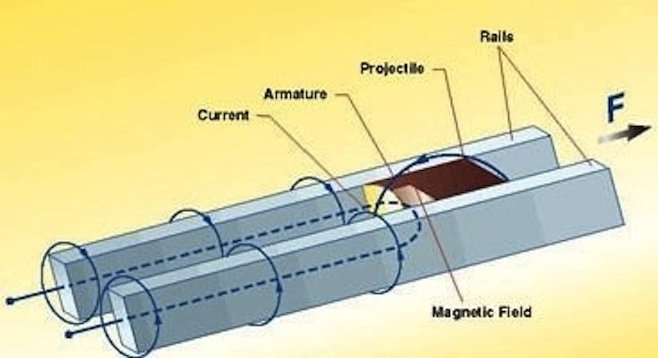 Facebook
Facebook
 X
X
 Instagram
Instagram
 TikTok
TikTok
 Youtube
Youtube

San Diego’s General Atomics, manufacturer of the controversial Predator and Reaper drones used by the U.S. military and others, has announced significant progress on a more conventional piece of weaponry that could be ready for production in as little as two to three years: the Blitzer electromagnetic railgun.
The company has been working on similar ship-mounted guns since the 1980s and received a military grant to continue research in 2011, but this version of the Blitzer would be suitable for mounting on land-based vehicles.
With the ability to launch a projectile at speeds of up to 11,500 feet per second without using an explosive charge — roughly four times as fast as a bullet fired from an M16 rifle — such a weapon could propel projectiles capable of doing as much damage as a Tomahawk missile at a fraction of the cost. General Atomics also touts the improved safety to troops, who wouldn't be carrying as much volatile explosive material into combat.
A working demonstration model of the Blitzer is expected by 2016, according to reports, with full production capabilities in place by 2019.


San Diego’s General Atomics, manufacturer of the controversial Predator and Reaper drones used by the U.S. military and others, has announced significant progress on a more conventional piece of weaponry that could be ready for production in as little as two to three years: the Blitzer electromagnetic railgun.
The company has been working on similar ship-mounted guns since the 1980s and received a military grant to continue research in 2011, but this version of the Blitzer would be suitable for mounting on land-based vehicles.
With the ability to launch a projectile at speeds of up to 11,500 feet per second without using an explosive charge — roughly four times as fast as a bullet fired from an M16 rifle — such a weapon could propel projectiles capable of doing as much damage as a Tomahawk missile at a fraction of the cost. General Atomics also touts the improved safety to troops, who wouldn't be carrying as much volatile explosive material into combat.
A working demonstration model of the Blitzer is expected by 2016, according to reports, with full production capabilities in place by 2019.
Comments